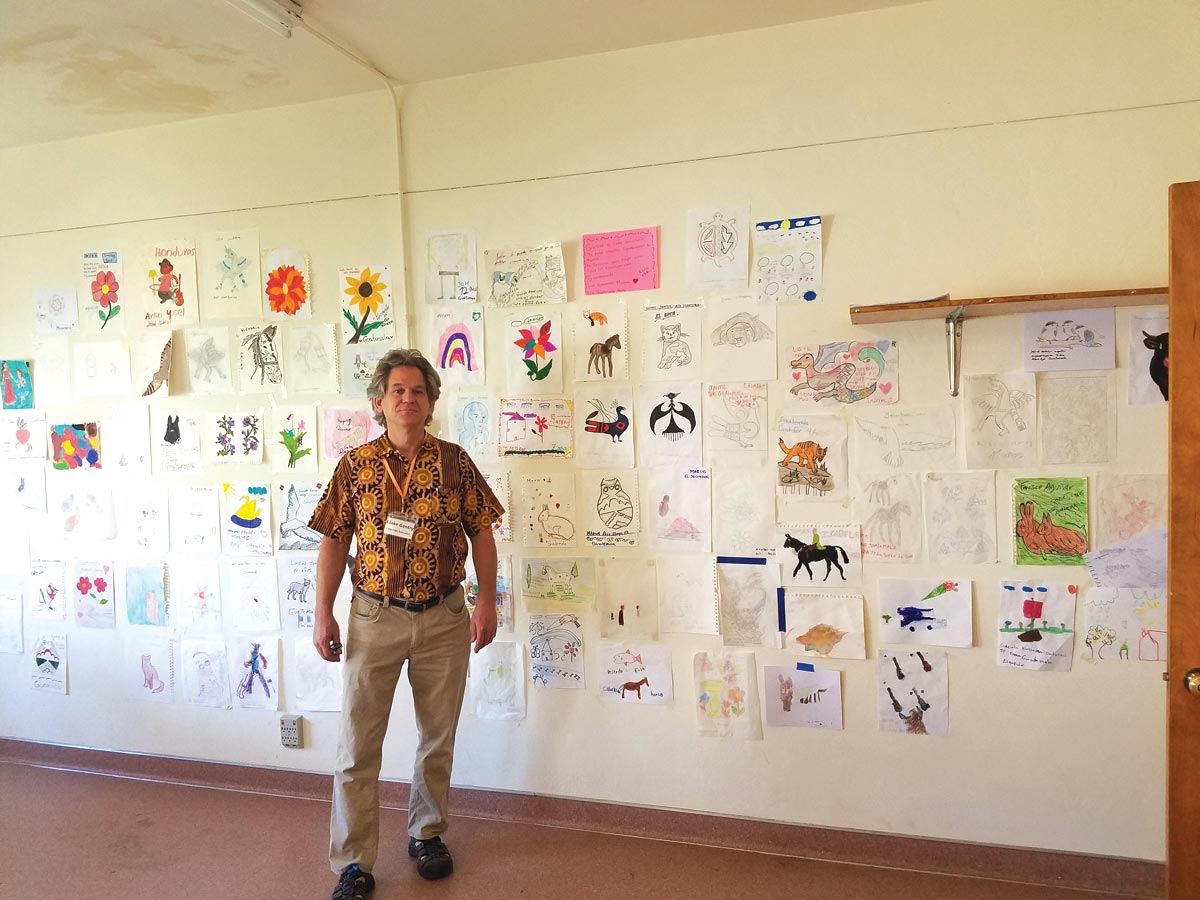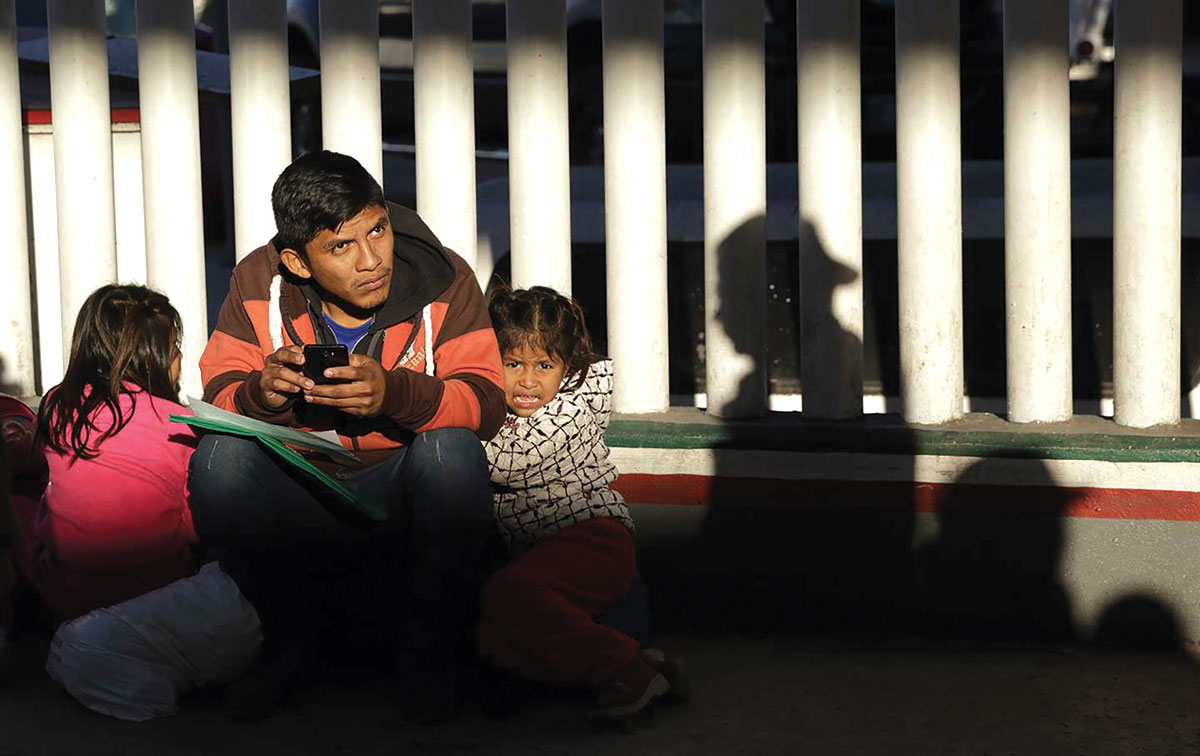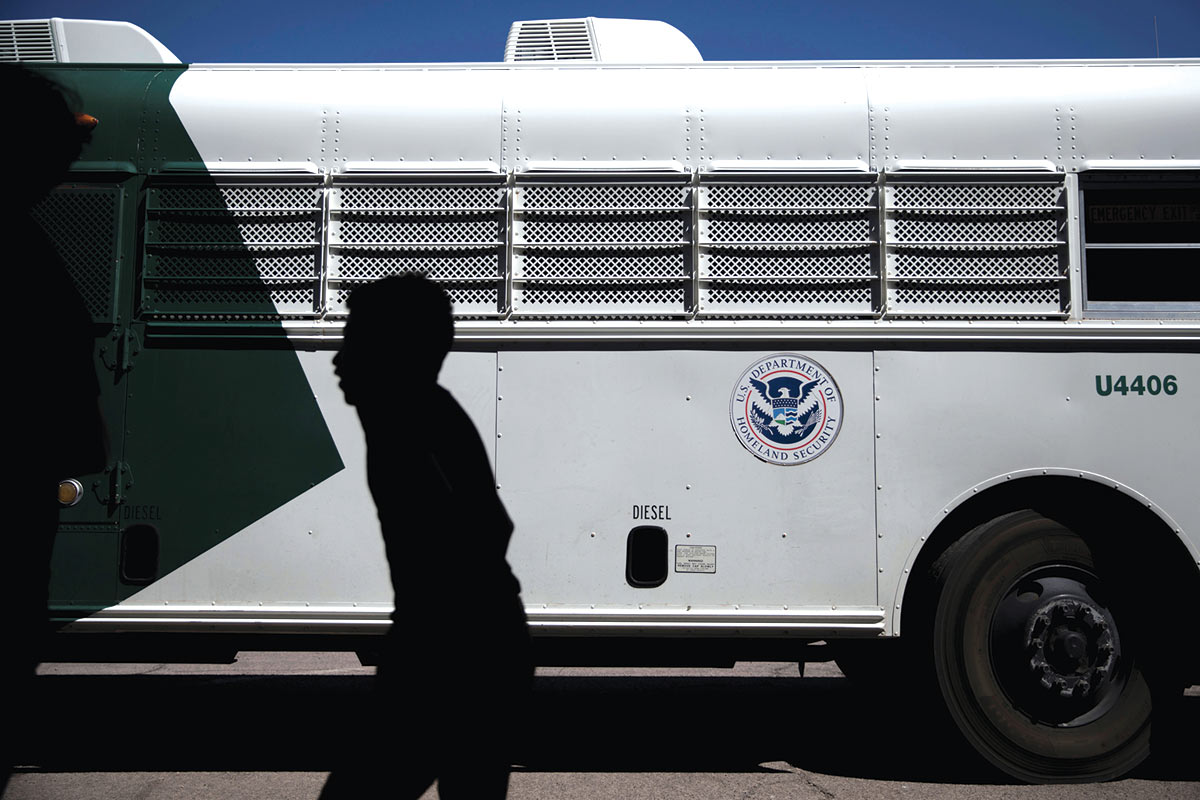At 10:52 am on Friday, May 3, a large bus emblazoned with Department of Homeland Security decals, its windows whited out, stops outside the little adobe City Square Church less than a mile south of downtown Phoenix. The doors open, and 50 bedraggled asylum seekers, men and women with their children in tow or clasped to their breasts—and all, without exception, brown-skinned—descend the steps of the bus.
All of them have bracelets with identifying information on their right wrist. On other occasions, when detention centers run out of bracelets, activists report, the guards have simply written the identifying numbers onto the immigrants’ forearms in black Sharpie. Disconcertingly, Eddie Calderon, a 23-year-old DACA recipient who works for Jews for Justice and spends his days helping immigrants, tells me this on Holocaust Remembrance Day.
One adult in each family has a monitor attached to his or her ankle, which must be charged every 12 hours. The asylum seekers are desperate, poor, often fleeing agricultural collapse, ecological crisis, and endemic gang violence in their home countries. Almost all are unhealthily skinny, and many of the children and infants are clearly sick. They cough—deep, phlegmy coughs; they have fevers; their eyes are rheumy. There are 4-month-olds who weigh as little as 11 pounds, about a third less than the average for infants that age. Most are dressed in worn hand-me-downs. None have shoelaces or belts, which were confiscated as potential suicide aids by the guards in the immigrant-detention centers where they were held until a few hours before.
Constrained by court rulings that limit how long immigrant families can be kept in detention—and frustrated by the people-smuggling networks’ new strategy of dumping entire families at or near ports of entry and telling them to claim asylum—Immigration and Customs Enforcement is freeing them into the streets of Phoenix and other major Southwestern cities. This is in keeping with the Trump administration’s apparent desire to humiliate and demonize those fleeing poverty and violence rather than address their causes.
The would-be asylees are given paperwork telling them the day of their first court hearing; a brown-paper-wrapped lunch consisting of a soggy bologna sandwich, potato chips, and an apple; and a plastic DHS bag for their possessions. And then ICE washes its hands of them. Most of the time, what little money the immigrants had was confiscated, along with their cell phones. If they can’t get to that first hearing in their court case—often far away, in the city where their sponsor lives, and usually scheduled to take place only a few days after they are released—they lose their chance at asylum and risk immediate deportation. Many of them are Maya from the Central American highlands and speak neither English nor Spanish. They are in limbo both physically and linguistically.
Popular
"swipe left below to view more authors"Swipe →
In late 2018, when the current surge in asylum-seeking migrants began, an overwhelmed ICE simply dumped hundreds of people a day at the Greyhound bus station near Phoenix’s Sky Harbor airport. After Greyhound protested the turning of its facility into a de facto shelter for destitute, confused, and scared asylum seekers, ICE began depositing them on the corner of Buckeye Road and 24th Street, outside the bus terminal, with no money, no phones, no watches, no bus tickets, no water, and almost no food; often the immigrants didn’t even know what city or state they were in. It was an uninviting, even intimidating, place to leave them: Traffic roared past, five lanes in each direction, and the scrubby area between the street and the bus station where the immigrants huddled was littered with cigarette butts, empty bottles, and used syringes.
A similar story began playing out 100 miles to the east, in the liberal enclave of Tucson. As President Donald Trump ratcheted up his rhetoric about a “border crisis” and “hordes” of migrants heading north, the DHS bureaucracy began systematically inundating Southwestern cities—especially, it appeared to activists, those with a progressive bent—with these penniless families.
In past surges of immigrants from Central America, ICE or its precursors would release them in a steady stream, a few dozen people a day. This time, Customs and Border Protection has been bottling people up, then handing hundreds of people over to ICE to release in cities all at once. Observers like Elizabeth Oglesby, a professor of Latin American studies at the University of Arizona in Tucson, believe the clear intent is to gin up a sense of crisis and force Congress to rewrite the rules, thereby allowing kids to be kept in detention centers and denying due process to those claiming asylum. But that sense of crisis, she adds, is misleading. Even with the recent surge, the number of people being apprehended at the border is only about half what it was in 2000 and remains lower than it was in the early 1980s, when hundreds of thousands fled the US-fueled civil wars in Central America.
Of course, back then the border was more porous. It was common for adults to head north alone, work in the informal US economy for a few months, and then return to their families. But over the past couple of decades, under Democratic and Republican administrations alike, the borderlands have become so heavily militarized that the back-and-forth option is no longer feasible. Now when adults head north, it is for keeps, so they bring their entire family with them. And just as the War on Drugs didn’t end drug sales or use but did fuel a prison-industrial complex and empower ever more ruthless cartels, the militarization of the border hasn’t ended undocumented immigration but rather has dramatically expanded the immigrant-detention complex, as well as the power of the criminal syndicates that ferry poor people across one international border after the next until they reach the United States.
Perversely, however, in policy documents and reports dating back to the 1990s, the Immigration and Naturalization Service and its successor agencies under the DHS consider the increased reliance by immigrants on people smugglers, as well as the rising prices charged by smuggling networks, to be measures of the success of their border-security initiatives.
The militarization of the border has also spurred immigrants who make it onto US soil to claim asylum rather than travel undetected to the interior to seek work in the informal economy. They do so because it is harder to sneak across the border undetected with an entire family—even in the remote and deadly desert regions—and also because the smugglers have realized they can turn more of a profit by simply dropping off busloads of destitute immigrants at ports of entry rather than smuggling them on foot, over many days or weeks, through dangerous backcountry.
For the cartels, it’s a win-win: Regardless of whether the immigrants qualify for asylum, the smugglers are paid for facilitating their journey. If those seeking asylum don’t qualify and then try to re-enter the United States, they have no choice but to pay even more to be smuggled in at remote parts of the border where it’s less likely they’ll be caught.
In response, argues Blake Gentry, a language specialist who works with migrants in Tucson, an increasingly rattled US government has embraced a policy of punishment and humiliation in the border zones to try to stop the human flow. Trump didn’t invent this response; he’s just fine-tuning it. What he has done “in such a crude way,” Gentry says, is simply to take the long-established humiliation rituals of the borderlands and spread them around the country. And he has done so not to solve the Central American refugee crisis but to throw red meat to his xenophobic political base.
In Trump’s focus on building a wall to keep out poor people from points south, in his embrace of “metering” on the border, in his decision to bottle up asylum seekers for weeks at a time on bridges south of the border and to place children in cages, in his rhetorical glorification of catch and detain and the use of industrial-scale camps to indefinitely house would-be immigrants, in his urging of an end to due process, in his endless denigration of immigrants in his speeches and tweets, and in his ridiculing of starving, terrified people, he has magnified and fetishized punishment trends long in the making.
Not surprisingly, none of this has worked as a deterrent. Desperate people have always moved in search of food and security for themselves and their children, and they likely always will. After all, to embark on such a perilous journey with their children, they must have already concluded that they have nothing left to lose. “There’s no more crops,” an immigrant from eastern Guatemala says, explaining why he borrowed roughly $4,000 to pay smugglers to bring him and his 16-year-old son north. His wife and 11 other children remained behind, to follow if he finds a foothold in this new land. “The cattle have moved in, and the rich have destroyed everything. The environment is heating up. They’ve replaced cropland with pastureland, and the grasses make the land hotter. So we, the poor, we’re without anything.”
In fact, says Alicia Dinsmore, a volunteer with the Kino Border Initiative who regularly heads to Mexico to work in soup kitchens just south of the border, where recently deported migrants cluster, the tougher Trump talks, the more desperate and determined people become to enter the United States sooner rather than later—to get in before the narrow window of opportunity is shut for good. “If people are in any way contemplating asylum as an option, it makes more sense to be seeking it now than a year or two from now,” she says. In short, in talking about a migratory “crisis,” Trump has simply added fuel to the fire he claims to want to douse.
In early April, ICE provided The Nation with estimates on the number of family members released from December 21 to April 1: 12,745 in the San Diego area; 22,000 in the Phoenix area; 37,500 in El Paso, Texas; and 53,320 in the San Antonio, Texas, region. Tens of thousands more were released in the months before December, and many thousands more after April 1. Other cities along the border, including Tucson and Yuma, Arizona, have also seen numerous asylees released onto their streets.
In response, progressive communities in Phoenix and Tucson have engaged in a dramatic and massive mobilization, much of it through churches and other places of worship. It has become, in recent months, one of the most heroic and effective grassroots efforts to counter the cruelty of the Trump years, helping tens of thousands of people as they await court decisions on their asylum cases. It stands as a testament to the power of ordinary people to do extraordinary things when confronted by state-sanctioned cruelty.
Within days of the surge in DHS drop-offs, and to the fury of an array of local right-wing militias and self-proclaimed Patriot groups, a huge range of community organizations—many of them faith-based—swung into action to rescue the destitute asylum seekers. Churches were opened up to provide orientation sessions, health checkups, meals, and transportation to the immigrants’ sponsor families around the country. Local residents offered spare bedrooms to provide a night or two of accommodation before the migrants continued on their way. Volunteer doctors and nurses tended to the sick. Grandmothers heeded the call to cook hot meals for people who often had eaten no more than bologna sandwiches and ramen noodles for days on end while in detention.
As a symbol of the interfaith nature of the relief effort, on Easter Sunday, Jewish groups coordinated with Muslim volunteers to cook meals to be served to immigrant families in the churches where they were staying. On Christmas in Tucson, synagogue members cooked up a beef brisket for the new arrivals.
“I know exactly how they feel,” says Calderon, who was brought to the United States from Mexico by his mother when he was 4, as he fills his maroon truck with bags of donated supplies that he will drive to several shelters around town that morning. On his upper right arm is a tattoo of a mariachi band—a tribute, he says, to his home state of Michoacán. The muscles under the tattoo bulge as he lifts one bag after another into the back of his vehicle. “We have to help the immigrant. We have to help the needy. It’s a mitzvah. The Jewish culture is about being the stranger in the land of Egypt. Every man is created in the image of God, so if you disrespect a man, you’re disrespecting God. Repairing the world is something we live by—tikkun olam.” It’s an ethos that is described in the Ethics of the Fathers quote on the back of his T-shirt: “You are not obligated to complete the work, but neither are you free to desist from it.”
The International Rescue Committee, which has worked with refugees around the world, began a shelter operation that, its staffers say, is now on a scale they’d previously attempted only in war zones. In Phoenix, the St. Vincent de Paul charity started housing upwards of 100 released migrants per night in its shelters. A network of evangelical Latino churches, coordinated by a pastor named Magdalena Schwartz, opened up its churches as way stations. Lutheran Social Services appealed to a huge network of donors, got local restaurants involved in giving food to hungry detainees, and rallied businesses to donate everything from tampons to diapers, cell phones to backpacks.
“Our community is united in the fact that when people are released and here legally”—and that includes asylum seekers, despite Trump’s claims to the contrary—“we want them in a shelter, want their basic needs provided for,” says Sarah Eary, the community-integration manager for refugee resettlement at Lutheran Social Services of the Southwest and director of the organization’s newly established asylum-seeker program. “We do not accept that they will be dropped on a street corner with absolutely no way to fend for themselves. It’s a humanitarian issue. We will not allow an atrocity to occur in our community.”
In Tucson, Catholic Community Services converted the beautiful disused Benedictine Monastery into a reception center capable of housing, clothing, feeding, and providing medical care to hundreds of immigrants.
Local militia groups took to running armed pickets outside the rescue missions, harassing and shouting at the migrants as they got off the DHS buses. Eventually, though, ICE began coordinating on the down low with these humanitarian networks. ICE agents would phone to let them know when busloads of detainees were about to be released and agree to drop the hungry migrants at churches instead of bus stations. Soon, a schedule was worked out as to which churches would receive immigrants and when. “We are receiving families every day,” says Schwartz, whose network has gone out of its way to establish a good rapport with law-enforcement agencies, organizing regular breakfasts with police and sheriffs’ departments and in recent months inviting representatives from ICE and CBP to attend. “I have eight to 10 churches every week—small, evangelical, Spanish churches—[helping] up to a thousand people a week.”
As the migrants step away from the bus at city Square Church, squinting in the fierce desert sun, they are met by a welcome committee of locals—coordinated by a volunteer with All Hands AZ named Jen Buck, wearing a “Free hugs” T-shirt—who have arrived at the church over the past half-hour with bags of food, clothes, toys, and medical supplies. Each one welcomes the migrants, smiles warmly, and extends a friendly hand. The migrants look disoriented, unsure if the kindness is a trap. After all, for days on end, they have been at CBP detention facilities in vastly overcrowded, fetid holding cells, where the lights were kept on 24/7, the only drinking water was from a faucet next to the restrooms, and the only pillow was a toilet bowl or a fellow detainee’s lap.
Some migrants report being held in large rooms with up to 150 other people, with only two toilets available. One family I spoke with was forced to sleep outside in the cold desert night with only a thin Mylar blanket to warm them. It was then, they said, that their 4-month-old daughter Camina started coughing and developed a fever. Three times that week, her parents asked for a doctor to examine her; each time, the guards refused. Camina’s 18-year-old mother told me that one officer said to her in Spanish, “We didn’t ask for you to come. You came. You are illegals, and it’s not my job to help the baby.”
At another church, Monte Vista, a young man and his 12-year-old son told me how they’d survived a kidnapping for ransom in Mexico on their journey north from Guatemala. They were held in a barren room for days by gun-toting gang members, along with more than a dozen other migrants, until their families back home could raise money for their release. Then, when they finally arrived in the United States, they were promptly detained by armed Border Patrol officers and put into another cold room, with concrete floors and no beds. The young man estimated that the room was 20 by 10 feet, with 32 people crammed into it.
“The first night, we didn’t sleep because we couldn’t fit,” he said. “The lucky ones who were able to lie down, people sat on top of them. It smelled like filth, like a dirty restroom. All of us had not showered for days. It smelled like sweat, dirt, shit, urine. Everybody gets sick. Everybody’s throat starts to hurt.”
The Nazis crowded Jews into ghettos, immiserated them, reduced their access to food and water, and then ridiculed their poverty, their dirty clothing, their smelly bodies, their propensity to disease. Long before the final solution was dreamed up by Hitler and his henchmen, they used these images in their media to make the broader public afraid of Jews—afraid of them as vectors of disease, immorality, and crime. One could see the treatment of vulnerable asylum seekers today in a similar vein: the state-sanctioned humiliation, the relentless demonization by outlets such as Fox News.
Quickly, the men, women, and children at City Square Church are ushered off the street and onto church grounds and then taken into the sanctuary. Once the gate closes behind them and the DHS bus departs, one can almost feel their collective sigh of relief.
Inside, volunteers are putting the last touches to steaming vats of soup, unwrapping packages of muffins, laying out trays filled with clementines and apples. In the waiting area outside the sanctuary, others are setting up a bank of cell phones, ready to start calling bus companies and airlines to book tickets as soon as the sponsors for each family come up with the money to send them to the homes where they will live while their asylum cases wend their way through the courts.
A Spanish-speaking volunteer named Marta is preparing to give a talk on cultural acclimation, on everything from flushing used toilet paper instead of putting it into trash bins to not crowding people in lines for bus tickets. Outside, in a lot behind the church, a company has set up four portable shower units for the migrants, many of whom did not have access to showers in the CBP centers.
Meanwhile, in a little three-room building off to the side of the church, a doctor is preparing to examine every immigrant, on the alert for measles, meningitis, scabies, whooping cough, hepatitis A, intestinal parasites, foot fungus, pneumonia, and flu. “I used to do this type of work in a bunch of African nations and India,” says the doctor, who asked to remain anonymous. “It’s what I’m seeing now two miles from my apartment—my own private Somalia.” She says she has done volunteer work for nine years and believes her patients picked up the diseases in the overcrowded, unsanitary detention centers.
The coughing and congestion come on fast and hit hard. I know because after I returned home from Arizona, I was down for the count for days.
The doctor can hardly contain her fury that this is occurring in the United States in 2019. “The last time I saw this was in Zimbabwe,” she says. “I’ve never seen it in the US before.”
At the Benedictine Monastery in Tucson, the volunteer doctors and nurses from the Registered Nurses Response Network have treated scabies, chicken pox, malnutrition, tuberculosis, blisters, and flu. They have encountered people on the verge of diabetic comas, their insulin confiscated by Border Patrol agents during their time in detention; others have had epilepsy and seizure-disorder medications taken from them. Several women have become pregnant after being raped on their journey north.
The immigrants have come to the United States seeking help. Some clearly have legitimate asylum claims, but since economic desperation alone is not grounds for asylum, many others will likely be returned to their home countries. They have made the journey here, however, hoping to find a better future. But in these churches, volunteers tell me they’ve heard stories of teenage girls being sexually assaulted by Border Patrol guards. And migrants report being made to drink vile-tasting restroom tap water in the overcrowded detention centers. Some say they were deprived of food by their guards; others recount being mocked and shouted at for not speaking English or Spanish. In the borderlands, armed right-wing militias prowl, itching for a fight with those their president labels “invaders,” as well as with the various humanitarian groups, such as No More Deaths, that drop water along migrant routes in the searing desert.
What is happening in these southwestern cities is a battle for America’s soul. Who wins will determine whether the Statue of Liberty or border walls and detention camps housing tens of thousands of people will end up representing this country in the eyes of the world. In evil times, those who do good too often end up facing the wrath of the powerful. In the end, it is only strength in numbers that will sustain the forces of decency in this fight.
For Rabbi Shmuly Yanklowitz, who has worked on social-justice issues all his adult life, the stakes couldn’t be higher. In the battle over how destitute asylum seekers are viewed and treated, he sees a larger struggle over what kind of a country and a world we’re creating. On one side, he sees people consumed by fear and hatred, people who trumpet “a return to tribalism,” he says. On the other, he sees volunteers pushing for a “spiritual revolution, a sense of interconnectivity, that we’re all in it together.” He isn’t entirely confident that his side will win, but he knows they have no choice but to keep fighting. “I have enough of a hope within me that good people can turn it around that it keeps me active,” Yanklowitz says in his Phoenix office, his many diplomas arrayed on the wall above him. “And even if we can’t, there are people suffering today we can help, and that still matters.”
On Easter Sunday, Sarah Eary from Lutheran Social Services spent her day working with asylum seekers. She encountered a woman with a sick baby and ended up spending much of the afternoon cradling the child in her arms. Shortly afterward, Eary got sick. She began coughing, and her fever rose to 102 degrees. For two days, she could do little more than sleep. But instead of resenting the migrants for making her ill, she says fiercely, holding that sick baby “was the joy of my life.”
“We don’t know where this is ending,” Eary adds. “But we’re committed as a community to see this through, to organize our resources, galvanize our partners, and work together. To me, it is the expression of our unified belief that we will not let this happen. We just will not let this happen.”






